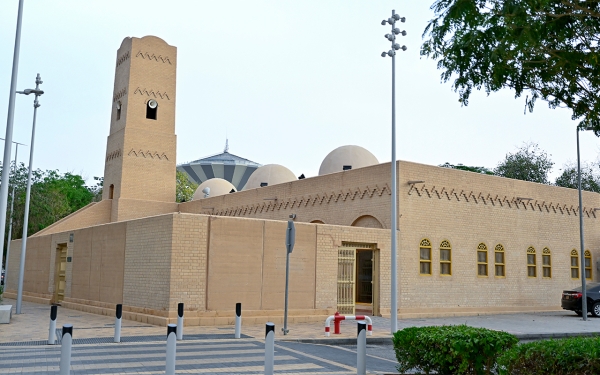





The King Abdulaziz Historical Center (KAHC) is a national landmark and a civilizational and cultural showcase in the Kingdom of Saudi Arabia. Located in the historical al-Murabba Neighborhood in downtown Riyadh City, KAHC was built by the Royal Commission for Riyadh City on an area of 440,000 m and was inaugurated on January 22, 1999, to mark one hundred years since the entry of the Founding King Abdulaziz Bin Abdulrahman Al Saud into Riyadh. The KAHC aims to enhance the national value of the Kingdom, its culture, and its civilization.
Design of KAHC
The KAHC’s design was inspired by the city of Riyadh’s heritage, historical, and cultural urban identity and was overseen by the Royal Commission for Riyadh City. The KAHC includes a number of cultural facilities attractive to visitors, such as the National Museum, King Abdulaziz Foundation for Research and Archives (Darah), King Abdulaziz Public Library, and King Abdulaziz Auditorium, in addition to historical installations including the Murabba Palace, a handful of ancient buildings, the old compound’s wall, and a number of public facilities such as the King Abdulaziz Mosque.
The KAHC is surrounded by a park and green spaces, featuring a number of plant and tree species that help reduce pollution, purify the air, and lower ambient temperatures.
Facilities of KAHC
KAHC contains a number of facilities and installations, including:
- Public Park: Consists of several elements, such as parks, the main square called al-Murabba Square, plazas, a palm oasis, an old well, water streams, and a lake.
- National Museum: The two-story museum occupies the KAHC's eastern side, stretching across an area of twenty-eight thousand m, and contains artifacts, manuscripts, documents, and display boards. It also uses multiple displays, documentaries, and scientific films within eight main exhibition halls, sequentially arranged from the oldest to the newest, namely: the Hall of Man and the Universe; the Hall of the Arab Kingdoms; the Hall of the Pre-Islamic Era; the Hall of the Prophet's Mission; the Hall of Islam and the Arabian Peninsula; the Hall of the First Saudi State and Second Saudi State; the Hall of the Unification of the Kingdom; and the Hall of Hajj and Two Holy Mosques, plus two timed display halls.
- King Abdulaziz Foundation for Research and Archives (Darah): A cultural and scientific institution founded in September 1972 over an area of 1,201 m within a land area of seven thousand m. The Darah serves the history of the Kingdom and its dissemination, as well as the history of the Arabian Peninsula and the history of Arabs and Muslims. Darah also supports scientific research and translation and contains several centers and departments serving researchers.
- The Heritage Commission: It consists of the commission’s two-story building, overseen by the Ministry of Culture, with an estimated area of three thousand m, comprising a ground floor dedicated to administration and research, the first floor to restoration activities and registration procedures.
- King Abdulaziz Public Library (al-Murabba Branch): A charity library, established by order of King Abdullah Bin Abdulaziz Al Saud and inaugurated in 1988. It has a surface area of roughly 9,800 m. The library serves all members of the community and consists of several facilities, including an audiovisual hall and a rare book and manuscript hall.
- King Abdulaziz Auditorium: A hall equipped for theatrical activities, events, scientific seminars, and conferences, with an area of 2,500 m.
- Al-Murabba Palace: One of the main, outstanding historical elements of the King Abdulaziz Historical Center. It was constructed by order of King Abdulaziz in late 1937, when a group of palaces and a diwan of King Abdulaziz were built outside Old Riyadh in al-Murabba District and became his family's residence.
- Mud Houses: These houses have been restored to reflect the urban and architectural fabric of the Old City, over an estimated total area of 6,800 m, and host temporary cultural activities and some official reception events in addition to the museum.
- Red Palace: A palace belonging to King Saud Bin Abdulaziz Al Saud, built in 1948 and dubbed the Red Palace because of its color. The Royal Commission for Riyadh City transformed the palace into a heritage, historical, and cultural museum.
- King Abdulaziz Mosque: A 4,200-worshiper mosque, rebuilt within the King Abdulaziz Historical Center Project.
- Al-Madi Mosque: The mosque was first built in the 1960s and has since been rebuilt, with its area and buildings expanding within the project's scope. Its design is based on the vernacular of local architecture and can accommodate up to five hundred worshipers.
- Water Tower: One of Riyadh's oldest architectural monuments, built in 1971, to increase pressure in the public water grid to meet the growing need for water as Riyadh sprawls.
Related quizzes
Related articles

